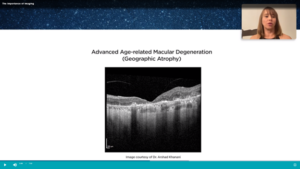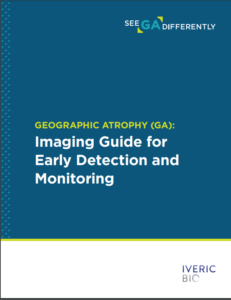

Imaging is critical to the detection and monitoring of geographic atrophy (GA). In The Importance of Imaging, SriniVas Sadda, MD, talks with Eric Donnefeld, MD, and Diana Shechtman, OD, FAAO, about how imaging technologies can help them evaluate macular degeneration and geographic atrophy (GA).
The three eye care professionals review the imaging technologies and discuss what they look for in images.
Optical coherence tomography is widely available in most eye care offices and can be used for early changes. The video shares images of various stages of age-related macular degeneration and GA in particular.
Dr. Shechtman notes that she looks for drusen that can progress to GA.”These are the precursor byproducts that can regress as the beginning of GA begins to take hold.
In an image showing more advanced AMD and GA, she notes that the patient would be experiencing critical functional disruption, problems reading and driving and seeing clearly in areas of poor illumination.
Fundus autofluoressence has become a gold standard in retina for diagnosis of GA. Dr. Shechtman explains how she likes to keep her patient education simple, comparing the areas of hyperautofluorescence around atrophic lesions to areas that a brushfire burns away.
Finally, the three look at color fundus photography and way that these images can help practitioners make the diangosis. GA is “hiding in plain sight,” says Dr. Donnefeld.


Imaging is an important step in diagnosis and monitoring of early, intermediate and advanced AMD/GA.
Readers can watch the video and download a copy of the Imaging Guide for Early Detection and Monitoring here.
Read other stories about how ODs are detecting and talking with patients about GA here.
This content is independent editorial sponsored by Astellas. Astellas had no input in the development of this content. Astellas, formerly Iveric Bio.



